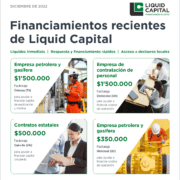To experience growth in the manufacturing industry, companies need to be ready to pivot in the face of changing conditions.

While demand has recently been steady for companies in some sectors, for others it has eased off. For instance, this year in the manufacturing industry, persistent industry and economic roadblocks are making it hard for manufacturers to stay agile, meet their obligations and take advantage of opportunities to grow.
So what is the best way forward for manufacturers, no matter what scenario they find themselves in? Keep reading to find out more about the factors affecting growth in the manufacturing industry and why having the working capital to stay flexible is critical to success.
Unpredictability is the new norm for manufacturers
For most in the industry, conditions have been in a constant state of flux over the last three years, starting with the COVID-19 pandemic, where restrictions affected more than 85% of Canadian manufacturers in 2020.
The sector faced major supply chain issues between the onset of the pandemic and summer 2022. In Canada, the total number of manufacturers dealing with raw materials shortages nearly tripled during that time. And a July 2022 Deloitte survey of more than 200 U.S.-based manufacturing executives found that shipping delays and part shortages had the biggest impact on manufacturers’ supply chains in the previous 12 to 18 months.
Respondents also noted that their top operational concern is the rise in shipping costs, which Deloitte says rose by more than 77% from January 2021 to August 2022, due to rising fuel prices, labour costs and logistics challenges.
Manufacturers may have also experienced suppliers reneging on contract pricing, increasing their costs at short notice in response to rapidly shifting global conditions, such as COVID-19 restrictions and the war in Ukraine.
While sales came back – growing nearly 28% between January 2020 and June 2022 — challenges continue. Although the Bank of Canada notes that inflationary pressures from supply bottlenecks are easing, economic growth is expected to slow next year – to 1% in Canada and 0.2% in the United States.
Faced with their own economic hurdles, your customers may be paying their invoices at net 45, 60 or even 90 days – creating a longer payment cycle that hinders your ability to meet your payment obligations or even to take on more contracts.
In tough economic conditions, ensuring your manufacturing business can continue to thrive really means having enough working capital on hand to pay employees and meet day-to-day obligations, as well as purchase inputs and take advantage of any opportunities to grow your market share.
But as many traditional banks are tightening lending criteria, this may mean looking to a more flexible funding solution.

Alternative funding — helping manufacturers through a volatile market
Finding a funding partner that considers the creditworthiness of your customers — not the immediate challenges facing the industry — may be the ideal solution for manufacturing companies looking to meet day to day obligations in this environment, and those hoping to take advantage of strategic opportunities to grow.
Even if your manufacturing business doesn’t align with traditional lending guidelines, asset-based lending (ABL) or invoice factoring , can offer you alternative financing that’s both fast and flexible.
For companies with a strong credit rating and verifiable financial reporting (such as receivable and payable summaries), ABL has the ability to secure loans against your accounts receivable, inventory, equipment and real estate.
Similarly, invoice factoring can also help manufacturers accelerate their cash cycle, quickly replacing near-current assets — or invoices — with cash.
With factoring, Liquid Capital purchases your outstanding invoices, advances your business up to 85% of the value of your invoices and collects payment from your customers — which allows your company to avoid costly interruptions to your manufacturing cycle. You receive the working capital you need to pay employees, replenish inventory or components to make further sales — and take advantage of opportunities to grow your business.

Perhaps just as importantly for manufacturers in this market, by working with an alternative lender, you’re forming an invaluable partnership with an experienced advisor who has deep knowledge of your industry, will look past current challenges to see the potential in your business and will work alongside you to find the right funding solution.
Looking beyond traditional criteria
Take E-Systems Corp. for example – an electronic contract manufacturer providing services and products to major U.S. defense contractors, health care device manufacturers, and the entertainment and consumer electronics industries. Although the company was on a high growth trajectory, it still didn’t meet the rigid, technical criteria for traditional bank financing.
Invoice factoring represented the ideal way for E-Systems Corp. to free up money tied up in accounts receivable, to fund its rapid growth.

While E-Systems Corp. had a huge backlog of booked orders — almost $1 million worth — it lacked the funds to buy the supplies it needed to manufacture orders. To further complicate things, as the company formed through the acquisition of another firm, it was considered a new entity and didn’t qualify for traditional bank financing. The owners also were not willing to give up equity to attract additional capital.
However, its strong portfolio of credit-worthy invoices made the company a prime candidate for invoice factoring. Through factoring, the company was not only able to receive between $85,000 and $125,000 of funding each month, but also the critical advice and partnership that Liquid Capital provides that extends far beyond factoring.
“Whenever a company is growing, it will experience cash flow anomalies. Factoring helps us reduce the time delta between paying our suppliers and getting paid by our customers. It provides us with the up-front cash we need to finance our growth.” — Ron Finlayson, Chief Executive Officer & Chairman, E-Systems Corp.
For another manufacturing company seeking a more flexible approach to financing, Liquid Capital’s approach to invoice factoring also proved to be the right move. Ridgeline Manufacturing, manufacturers of aluminum recreational products primarily for the summer, had limited off-season cash flow and challenges accessing traditional financing as their building and tangible assets were only worth 40% of their original price tags.

While Ridgeline pursued invoice factoring with other providers, co-owner Nick Newman was not in favour of the short-term approach or lack of flexibility within most factoring contracts, including the need to pay interest on lines of credit even if he wasn’t using the funds.
After meeting with Liquid Capital, Nick liked the idea that there were no minimums and no penalties for factoring one day and not the next. He also appreciated that Liquid Capital didn’t charge interest on money already collected.
“Sure, factoring is higher interest, but we build it into the cost of our product and it’s seasonal. So if I pay more than I would with a bank, but can factor for just a few months a year, that’s a big bonus.” — Nick Newman, co-owner, Ridgeline Manufacturing
Staying flexible in this economy to achieve success
With conditions changing rapidly in the industry and the broader economy, a manufacturer’s ability to respond quickly to meet challenges or opportunities is crucial to success. Agile manufacturers are leveraging alternative funding to get quick access to the working capital they need, bypassing the bank bottlenecks that are even more pronounced in this economy, so they can keep things moving.
Are you or your client looking to access flexible funding for manufacturing? Contact a Liquid Capital Funding Expert today to learn how our alternative funding solutions can help you be ready for anything.





























